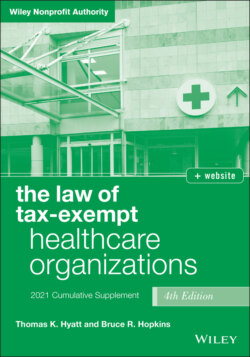Читать книгу The Law of Tax-Exempt Healthcare Organizations - Bruce Hopkins R., Bruce R. Hopkins, David Middlebrook - Страница 6
Preface
ОглавлениеThis is the sixth cumulative supplement to accompany The Law of Tax‐Exempt Healthcare Organizations, fourth edition. It reviews developments in the tax law affecting the tax‐exempt healthcare sector through 2020. It was a year of tumult, driven by the global response to a pandemic, made still more chaotic by a polarized government during an election year and an administration determined to deregulate while at the same time surprisingly adept at the rapid finalization of proposed rules in the tax‐exempt organization arena.
The congressional response to the COVID‐19 pandemic was to enact the largest economic stimulus legislation in U.S. history. The CARES Act impacted nonprofit healthcare organizations greatly by providing additional financial support after their rapid loss of revenue stemming from the cessation of traditional elective care and procedures and the ramp‐up to treat COVID patients. It included a forgivable loan program designed to ensure the maintenance of payrolls of which smaller healthcare organizations and related entities were able to take advantage. However, it was rolled out through ever‐changing real‐time “frequently asked questions” guidance that surely was never contemplated by the drafters of the Administrative Procedure Act.
In 2020, the IRS promulgated substantial proposed rules in connection with two major pieces of legislation, those pertaining to the allocation of expenses relative to unrelated business income under the “bucketing rule,” and the imposition of an excise tax on “excess compensation” received by executives of nonprofit organizations. Under the bucketing rule, an exempt organization with more than one unrelated business must compute unrelated business taxable income separately with respect to each unrelated business, as contrasted with the good old days when multiple unrelated trades or businesses could be aggregated together in order to reduce the tax bill. Under the excess compensation rule, if nonprofit executives receive compensation in excess of $1 million in salary or in certain retirement benefits, the employer is liable for a substantial excise tax payment on the amount in excess, with a carveout for income earned from certain medical services.
It would have been reasonable to assume that it would take some time for the IRS to digest comments received on these lengthy proposed regulations and to roll out final rules. Alas, this was not the case. Between the time that we began drafting this year's supplement in November and the return of the manuscript to us for review by the copyeditors in January, the final rules had already been published, necessitating a hasty update of these provisions in the supplement. We are at least pleased to report that this year's supplement is up‐to‐date, in these regards, as of February 1.
In other news, the IRS continued to tinker with compliance issues that have been challenging to regulate. These include continuing to impose the commerciality doctrine in a restrictive fashion on seemingly routine nonprofit business activities; enforcing the federal government's refusal to recognize the medicinal benefits of cannabis by declining to recognize exemption for nonprofits providing cannabis‐related services, by application of the public policy doctrine, notwithstanding the opposing viewpoint of a growing number of states; focusing virtually all of its audit activity on compliance by hospitals with the community health needs assessment provisions added to the Internal Revenue Code by the Affordable Care Act; and establishing substantially changed procedures for group exemption, presumably to address creative use of this opportunity by some organizations in recent years, in a fashion that the IRS admitted may impose additional administrative burdens.
In a time when guidance from the IRS as to exempt organization matters has significantly declined due to staffing and budget challenges, it can still be found in unlikely places. We have previously reported about the use of instructions to the Form 1023 and the Form 990 as a means of informally establishing new procedures and policies. This year we were able to glean meaningful intelligence from GAO reports issued in response to congressional inquiries that provided new detail as to IRS audit procedures and matters of interest.
As this supplement was going to press, a new president and a new administration were coming into view. Certainly, the election of President Biden portends the end of legislative efforts to undo the Affordable Care Act and the beginning of new efforts to strengthen and expand it. It seems likely that a federal government now controlled by the Democratic Party will move in new directions that are certain to result in changes to the law of tax‐exempt healthcare organizations. Stay tuned to this channel for breaking developments.
As always, we appreciate the assistance we have received from John Wiley & Sons in the preparation of this cumulative supplement. Our thanks are extended, in particular, to Brian T. Neill, development editor, Deborah Schindlar, project editor, and Jayaprakash Unni, production editor, for their assistance and support and connection with this cumulative supplement.
Thomas K. Hyatt
Bruce R. Hopkins
February 2021
